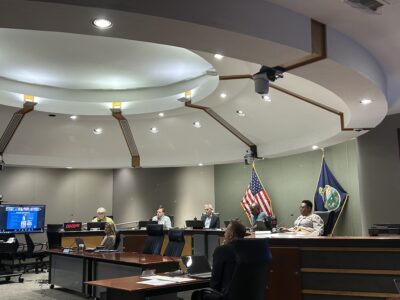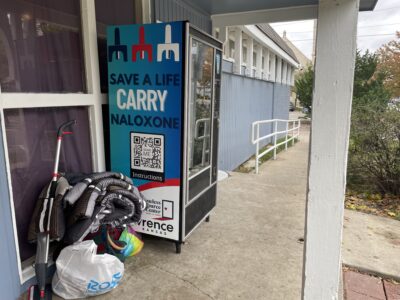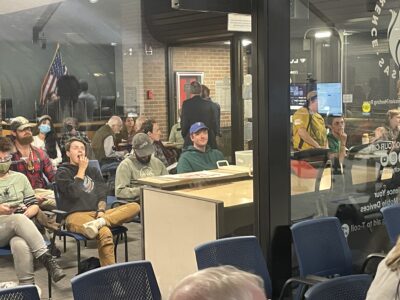Lawrence city commissioners get a ‘peek behind the scenes’ on how staff makes infrastructure decisions

photo by: Bremen Keasey
Lawrence City Commissioners listening to a presentation about the city's Asset Management Plan that includedmanaging its infrastructure and how it impacts the budget.
One thing Lawrence City Manager Craig Owens wrote down in his notes several years ago, during his first 100 days on the job, was that the city’s “infrastructure needs a lot of love.”
He told the Lawrence City Commission that on Tuesday night before city staff and financial advisers from Baker Tilly gave an overview of how the city decides which parts of its infrastructure need that love — and how the debt that’s used to fund infrastructure projects affects the city’s finances.
In his tenure, Owens said, the city has made significant progress on maintaining and reconstructing its infrastructure. He wanted the commission and the community to have a better sense of how the city analyzes data to plan for those improvements, which range from water and sewer projects to intensive reconstructions of arterial streets.
“Before we make any investments, we work to make sure they’re the right investments,” Owens said.
Mayor Mike Dever said the commission appreciated getting a “peek behind the scenes” of the complicated process. Multiple staff members from the Municipal Services and Operations division discussed how they’ve worked to optimize decisions and monitor the progress of infrastructure projects.
Some of those efforts are about deciding which projects to prioritize. For instance, Nick Hoyt, an engineering program manager, said the city modeled thousands of scenarios for water projects to figure out how they would improve flow and capacity. The department “studied the bejesus” out of those scenarios, he said, and the results helped the city evaluate which projects would be the best and most cost-effective solutions.
Other data analysis efforts have to do with regular maintenance and upkeep — deciding when it’s needed and how much is required.
Hoyt said that during the COVID-19 pandemic, the city installed closed-circuit TV cameras in some of its sewer pipes that were most likely to get backed up. The cameras would provide data on the conditions in the pipes so the city would know whether it made sense to clean them every month. The monitoring revealed that only a third of the pipes had enough gunk in them to require the monthly cleaning.
And Dave Cronin, a city engineer, said the city uses a pavement condition rating system to evaluate its streets, where 0 is the worst condition, 100 is the best and anything above 70 is “satisfactory” and means treatment projects are cheaper. Cronin said the condition of the city’s streets is estimated at 62.3, but the recent investment on large-scale projects has improved its arterial streets above that benchmark of 70. He said the city is spending a lot of resources on reconstructing Iowa Street, but that will lead to savings in the future.
“We won’t be spending as much money for the rest of the decade,” Cronin said.
Along with reviewing the infrastructure strategies, the presentation discussed the city’s Capital Improvement Plan process — which determines which big projects get constructed and when — and its debt practices.
The Capital Improvement Plan, or CIP, is a sort of blueprint for community infrastructure projects, and it contains specific projects that exceed $100,000 and either create a new asset or enhance an existing asset beyond its useful life. Rachelle Mathews, the city’s finance director, said that projects being considered for the CIP undergo a “very robust review,” in which staff forecasts the cost of the projects and their impact on the city’s debt. Mathews said that despite new debt-funded projects in recent years, the portion of the city’s mill levy that is used for debt service had held stable at just under 8 mills since 2023.
Even though the city has been doing more debt-funded projects, the financial advisers from Baker Tilly concluded the city was in a strong financial position. David Erdman, a representative with Baker Tilly, said the financial rating service Moody’s ranked the city’s general obligation bonds at Aa1 — a higher rating than the median of U.S. cities and comparable to other area cities like Overland Park and Olathe. Additionally, he said underwriters and investors “show strong interest” in purchasing bonds issued by the city.
Erdman said that while there is a conception that bond ratings are only tied to debt, Moody’s looks at additional factors like the local economy and then weighs all of them together.
One reason the commission had asked city staff to make this presentation was that some residents had raised concerns over the city’s debt management and whether it could handle its costs. A couple of commenters at Tuesday’s meeting did ask about the future impact on the city’s finances from its current debt levels.
But the commissioners, like Cronin, emphasized that the city’s expenses today would mean less financial pain in the long run.
Commissioner Bart Littlejohn likened the city’s infrastructure situation to maintaining a car. If you continually make repairs for a car that’s falling apart, he said, it might end up costing more over the long run than buying a new car. Instead of making piecemeal changes when problems arise, he said, he thought the approach the city was using was holistic and would lead to a lower cost of ownership over the long term.
“We’re trying to get on the path to make the most use of our investments and be the most (fiscally) responsible we can be,” Littlejohn said.
Dever said the information that city staff presented was like “showing work on a test.” He said it illuminated “all the moving parts” that city staff works on when managing its infrastructure, and that it showed the city was looking to invest its money well, rather than leaving the community on the hook for much more expensive work in the future.
“It looks like we’re doing it in a financially sound way,” Dever said.
• • •
In other business, commissioners approved a rezoning request that could pave the way for a mixed-use development in North Lawrence.
The commission approved a request to rezone 1.12 acres of land at 623 and 645 Locust St. from an M-3 mixed-use district to an M-2 mixed-use district.
The Lawrence-Douglas County Planning Commission unanimously voted to recommend the approval of the rezoning request during a meeting in August. During that meeting, Paul Werner, an architect representing the developers, said the plans called for a three-story building that would feature commercial use on the ground floor, residential uses on higher floors and a restaurant.
Although the site was already zoned for mixed-use development, the M-3 district would have required that at least half of the site be for nonresidential use, according to a city memo. Under that requirement, Werner said it would mean the structure would need to add another story, and so reducing the zoning to M-2 would better match the surroundings on Locust Street.







